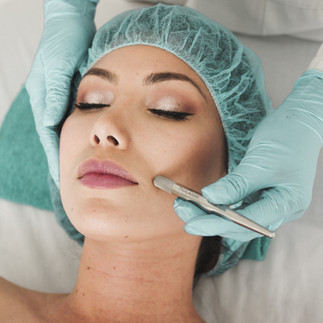The Midlife Melasma Connection: Prevalence in Asian and Darker-Skinned Women
- Dr Laurena Law

- Jul 1, 2023
- 9 min read
Melasma is a prevalent skin disorder that causes hyperpigmentation, typically appearing as brown patches on the face. Due to its frequent occurrence on the face, it significantly affects the quality of life of those affected. Managing this condition can be challenging, typically requiring extended treatment periods and multiple modalities for ongoing maintenance. Melasma is an acquired pigmentation disorder that poses difficulties in treatment due to its stubborn nature and high risk of recurrence.
Melasma, also known as chloasma or the mask of pregnancy is a common pigmentation disorder that predominantly affects the face and occasionally the forearms and back. It results in symmetrical brownish pigmentation that is acquired over time. The prevalence of melasma worldwide is estimated at around 1%, but higher rates have been observed in individuals with darker skin types (III-V), particularly those of Latin American (9-30%), South-East Asian, and South Asian (approximately 40%) heritage. Women are more susceptible to melasma than men, with the average onset age between 20 and 40 years, although it can start during adolescence. Hormonal factors are believed to be involved in the development of this condition.
Melasma has a clear association with estrogen, as evidenced by its connection to pregnancy and oral contraception. However, there is no direct link between menopause and melasma, although there have been cases of melasma developing after Hormone Replacement Therapy (HRT) treatment. It is essential to evaluate the risks and benefits of HRT on an individual basis. Topical preparations are generally considered to have fewer risks than systemic HRT and may be a preferable option for some individuals.
Interestingly, up to 80% of women who experience melasma on areas other than the face are postmenopausal, yet the underlying cause remains unclear. In Asian women going through perimenopause, Acquired Bilateral Melanosis (ABM) of the neck has been reported, but the etiology of this condition is unknown, and treatment response is often poor.
Diagnosing melasma is typically based on clinical features, which consist of symmetrical reticulated hypermelanosis in three primary facial patterns: centrofacial, malar, and mandibular. The most common pattern, seen in 50-80% of cases, is the centrofacial pattern, which primarily affects the forehead, nose, and upper lip, but not the philtrum, cheeks, or chin. The malar pattern is limited to the malar cheeks, while mandibular melasma occurs on the jawline and chin and is believed to be more common in older individuals with severe photodamage. Another pattern, known as extra-facial melasma, can develop on non-facial body parts, such as the neck, sternum, forearms, and upper extremities.

Copyright: Clinical patterns of facial melasma Reproduced with permission from Gupta M, Doolan BJ, Manungo F, Diagnosis of melasma and diagnostic tools, Opinions & Progress in Cosmetic Dermatology 2020;1:15-18.
It is important to consult a healthcare provider for an accurate diagnosis.
Pathophysiology of Melasma:
Despite uncertainties surrounding the pathogenesis of melasma, it is widely acknowledged as a photoaging-related disorder. Various causative factors have been identified that can trigger the release of vascular mediators, leading to angiogenesis and the activation of melanocytes.
The following factors have been implicated:
Ultraviolet (UV) light is a significant factor, as it can penetrate the skin's epidermis and trigger the release of reactive oxygen species, promoting melanin production (melanogenesis). Blue and purple light, which have shorter wavelengths in the visible light spectrum, are also known to cause long-lasting hyperpigmentation, particularly in individuals with darker skin types. Cumulative sun exposure can also lead to increased pigmentation in the skin, which often persists over the long term.
Having a family history of melasma is a significant risk factor for developing the condition. Studies have indicated that roughly 60% of individuals with melasma have a positive family history, indicating a possible genetic predisposition.
Hormonal influences, specifically oestrogen and progesterone, may play a role in the development of melasma. This is supported by the increased prevalence of melasma during pregnancy, as well as the use of oral contraceptives, menopausal hormone therapy, intrauterine devices, and implants, all of which contain oestrogen and progesterone. Human skin expresses specific oestrogen and progesterone receptors, which mediate the activities of these hormones and have been implicated in a quarter of affected women. Extrafacial melasma on the forearms has been linked to the perimenopausal state and the use of topical oestrogen replacement therapy, with oestrogen believed to be a more significant mediator than progesterone.
Certain ingredients in perfumed soaps and cosmetic products may trigger a phototoxic reaction that can initiate the onset of melasma. In addition, some systemic agents, such as anti-epileptic, antimalarial, antipsychotic, and cytotoxic/antineoplastic medications, have been associated with the potential to induce hyperpigmentation.
Extended occupational heat exposure or exposure to cooking fires has been proposed as a possible factor in the development of melasma, due to the potential for thermal and UV damage.
Melasma has been linked to endocrinological conditions, including thyroid disease. In patients with melasma, serum levels of thyroid stimulating hormone, antithyroid peroxidase, and antithyroglobulin antibody were found to be elevated compared to those without melasma.
General Tips for Managing Melasma:
It is essential to prioritize lifelong protection from light, including visible light, throughout the year.
To protect against ultraviolet A (UVA), UVB, and visible light, it is recommended to use a broad-spectrum sunscreen with a very high protection factor (SPF 50+) on the entire face daily, year-round. Sunscreens containing iron oxides are preferable, as they protect against UV radiation and some visible light. It's worth noting that all tinted makeup products, including creams and powders, typically contain iron oxide.
Cosmetic camouflage, such as makeup, can be extremely useful for concealing melasma pigmentation. Thicker, more opaque concealers can be used as foundation makeup to cover up the affected areas. Additionally, colour correctors can be utilized to help minimize the appearance of pigmentation.

Review of Melasma Specific Treatments:
Currently, therapies for melasma can be broadly classified into two categories: non-energy-dependent and energy-dependent treatments.
Non-energy dependent therapies: these include topical medicine such as hydroquinone (HQ), triple combined cream containing steroids, hydroquinone and tretinoin (TCC), azelaic acid (AA), oral tranexamic acid (oTA), topical tranexamic acid (tTA), topical vitamin C (tVC), visible and UV light protection cream, chemical peelings (PEEL), microneedles (MNs), platelet-rich plasma (PRP) or ultrasound therapy. They generally have lower risk but take effect slowly.
Energy-dependent therapies: include intense pulsed light (IPL), Q-switched (QS) laser, picosecond laser (PICO), non-ablative fractional laser (NAFL) or ablative fractional laser (AFL). These therapies have been observed to rapidly eliminate dark brown macules in patients with melasma. However, these therapies are also associated with a high risk of relapse or worsening of the condition.
Non-energy dependent treatments:
Hydroquinone (HQ)
In the treatment of melasma, Hydroquinone (HQ) as a topical cream, has been the subject of the most extensive topical agent research. This compound operates by inhibiting tyrosinase, a process that impedes the conversion of dopamine to melanin. However, skin irritation is common and long-term use can result in onchronosis (a bluish black discoloration of the skin).
Topical Corticosteroids
By non-selectively suppressing melanogenesis and acting as an anti-inflammatory agent, corticosteroids can prevent pigmentation. However, when used alone, they are unlikely to outperform other depigmenting agents. Although corticosteroids can independently suppress melanogenesis, the existing literature indicates that they have not been proven to have long-term benefits in treating melasma. Furthermore, prolonged use of steroids may result in telangiectasias, acne, skin atrophy, striae, and hypopigmentation.
Retinoids and Tretinoin
Topical retinoids have demonstrated efficacy in treating melasma, likely by encouraging keratinocyte turnover. A notable study from 1993 found that tretinoin 0.1% cream could significantly decrease objective measurements of melasma pigmentation. Additionally, another study has supported the beneficial use of tretinoin 0.1% cream in treating melasma specifically in dark skinned patients.
Tranexamic acid
Tranexamic acid is a medicine originally used to treat or prevent excessive bleeding. More recent application has seen growing use in the treatment of melasma via topical, oral, and injectable forms. Studies have shown mixed results when used as a monotherapy, but increased efficacy when combined with other pigmentation-based therapies.
Other natural topical compounds
Ascorbic acid and kojic acid can both inhibit tyrosinase activity and have demonstrated reductions in pigmentation in small studies. Ascorbic acid may additionally reduce inflammation in melasma lesions by decreasing reactive oxygen species. However, when used as monotherapies, both have been found to be less effective than hydroquinone.
Azelaic acid (AA), a natural compound derived from the yeast Pityrosporum ovale, was found to be effective in reducing pigmentation by inhibiting tyrosinase activity in an open-label study. In addition to its pigmentation-reducing effects, AA also possesses anti-inflammatory properties. While adverse effects are infrequent, they may include burning and erythema.
Recent research has indicated that combination topical therapies are more effective than monotherapies. The first combination topical therapy to receive approval from the United States Food and Drug Administration was Triple Combination Therapy (TCT), which combines HQ, a retinoid, and a topical steroid. In a randomized study with 260 Asian patients, TCT was found to be superior to HQ 4% monotherapy in improving melasma. Notably, about 50% of patients on TCT reported experiencing increased erythema, skin irritation, and discomfort, compared to 14% of controls.
Peels
Chemical peels are often used in conjunction with other topical treatments. According to several studies, superficial peels may be beneficial for the epidermal form of melasma. Some peels have demonstrated outcomes comparable to those of hydroquinone. Combination peels have also been researched and have shown effectiveness comparable to that of single-ingredient peels. However, some types of peels may lead to more side effects, such as burning and skin peeling.
Micro-needling
Micro-needling or mesotherapy is another supplemental treatment option that involves creating small channels in the skin to deliver small amounts of topical drugs intradermally. The micro-needling process can also trigger a helpful wound-healing response with fewer side effects than traditional resurfacing procedures. This technique may lead to deeper and more consistent placement of medication in the epidermis and dermis. Tranexamic acid has been combined with micro-needling with some benefit and appears comparable to oral tranexamic acid with less systemic effects.
Energy dependent therapies:
In recent years, laser therapy has been researched as a potential treatment for melasma, with varying degrees of success. Lasers utilize thermal energy to selectively target various chromophores in the skin. Non-ablative lasers are preferred over ablative lasers for treating melasma due to their tendency to cause less inflammation and subsequently less post-inflammatory pigment alteration (PIPA). Non-ablative Q-switched lasers, such as the Q-switched ruby laser (QSRL) and Q-switched neodymium:yttrium-aluminium-garnet (QNd:YAG) lasers, selectively target the melanin chromophore.
Newer studies have demonstrated improvements in pigmentation using low-fluence QNd:YAG laser therapy in conjunction with sunscreen, HQ, tretinoin, or ascorbic acid applied by patients after the laser treatment.
After reviewing the available literature, topical therapies such as HQ cream or combined tretinoin and hydroquinone are recommended as the first-line treatment for melasma, with a duration of at least 3 months. If this approach is not effective, combination therapy with chemical peelings may be considered as a second-line treatment. The third-line therapy involves adding laser and light-based devices to the previous treatments. However, there is no single treatment that has been proven to be highly effective for melasma. Currently, combination therapies are generally preferred.
Burning and stinging, redness, scaling, swelling, hyperpigmentation, and swelling were among the adverse effects observed. The most frequently reported side effects were redness and burning. Side effects were most commonly reported with non-ablative fractional laser (66%), micro-needling (52.3%), PICO (45%), PEEL (38%) and topical tranexamic acid (36.7%). Therapies with lower reported side effects were IPL, tretinoin, topical vitamin C, oral tranexamic acid and HQ (0-17.6%).
Interventions with multi-target effects tend to be more effective in treating melasma than those with a single target. In addition to inhibiting melanogenesis or destroying melanin granules, it is important to consider the inhibitory effect of tranexamic acid on ET-1 (endothelin 1), the beneficial effect on blood vessels and mast cells, and the ability of laser therapy to reverse the signs of photoaging on melasma. These treatment targets appear to be crucial in the management of melasma.
A combination therapy that involves multiple targets, such as the use of drugs, energy-based devices, or micro-needling, is likely to be more effective than single therapy, and it may help reduce the likelihood of melasma recurrence. Due to the high recurrence rate of melasma, maintenance treatments are often necessary, along with strict light protection measures to prevent the relapses that are typical of this chronic condition.
Managing melasma is a multifaceted undertaking that necessitates weighing the advantages and risks over an extended period of time due to the condition's recurrent nature. Numerous products and services are marketed with unrealistic claims. This article emphasizes that no single treatment approach has been shown to be effective for melasma, and people seeking treatment should seek advice from a qualified professional rather than opting for treatments based on popularity or enticing discounts.
If you have found this information helpful please comment, share, or subscribe to this blog.
You can contact us to book an online or in-person consultation via email or WhatsApp for an assessment and an individualised treatment plan for your skin pigmentation concerns.
References:
Liu Y, Wu S, Wu H, Liang X, Guo D, Zhuo F. Comparison of the Efficacy of Melasma Treatments: A Network Meta-Analysis of Randomized Controlled Trials. Front Med (Lausanne). 2021 Sep 29;8:713554. doi: 10.3389/fmed.2021.713554. PMID: 34660626; PMCID: PMC8511390.
https://www1.racgp.org.au/ajgp/2021/december/melasma
Kamp E, Ashraf M, Musbahi E, DeGiovanni C. Menopause, skin and common dermatoses. Part 2: skin disorders. Clin Exp Dermatol. 2022 Dec;47(12):2117-2122. doi: 10.1111/ced.15308. Epub 2022 Oct 26. PMID: 35727900; PMCID: PMC10092853.
Ogbechie-Godec OA, Elbuluk N. Melasma: an Up-to-Date Comprehensive Review. Dermatol Ther (Heidelb). 2017 Sep;7(3):305-318. doi: 10.1007/s13555-017-0194-1. Epub 2017 Jul 19. PMID: 28726212; PMCID: PMC5574745.
Doolan, Brent & Gupta, Monisha. (2021). Melasma. Australian Journal of General Practice. 50. 10.31128/AJGP-05-21-6002.
Batra J, Brar BK, Kumar S, Arora H. Tranexamic Acid in Melasma: Comparative Evaluation of Therapeutic Efficacy of Oral Tranexamic Acid versus Its Transepidermal Administration. J Cutan Aesthet Surg. 2022 Oct-Dec;15(4):394-399. doi: 10.4103/JCAS.JCAS_237_20. PMID: 37035597; PMCID: PMC10081479.















Comments